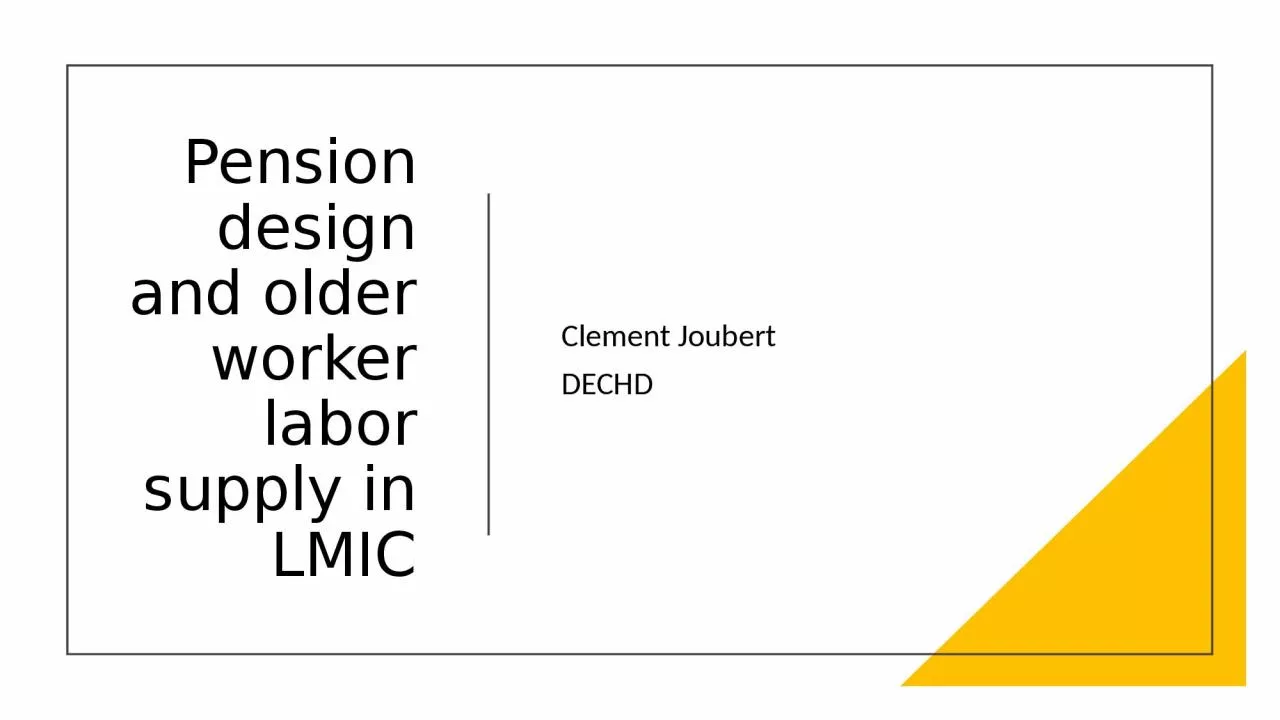

Clement Joubert DECHD Low pension coverage across people and over lifetimes 23 workers worldwide do not contribute to a formal pension scheme Even fewer consistent contributors particularly among women ID: 1028112
Download Presentation The PPT/PDF document "Pension design and older worker labor su..." is the property of its rightful owner. Permission is granted to download and print the materials on this web site for personal, non-commercial use only, and to display it on your personal computer provided you do not modify the materials and that you retain all copyright notices contained in the materials. By downloading content from our website, you accept the terms of this agreement.
1. Pension design and older worker labor supply in LMICClement JoubertDECHD
2. Low pension coverage across people and over lifetimes 2/3 workers worldwide do not contribute to a formal pension schemeEven fewer consistent contributors, particularly among womenSource: Pallares-Miralles et al. (2012) using World Bank Pension databaseSource: EPS and Chilean pension system data
3. Low earners have lower contribution densitiesContinuous formal employment histories tend to be associated with high earners Low earners are more likely to contribute infrequently or not at all, leading to low replacement ratesE.g.: Fraction with over 80% contribution densities in Peru’s SPPTop income quintile: ¾Bottom income quintile: ¼Source: Freudenberg & Toscani 2019
4. High LFP after age 65Male LFP by education levelMale LFP by self-reported health
5. Pension design challenge 1: Covering infrequent contributorsIn HI countries: Infrequent contributors tend to be married womenTypically married to a consistent contributorMain instrument: survivorship pensionsIn LMI countries: Infrequent contributors tend to be lower earning men and womenMany households lack a consistent contributor, so survivorship pensions are not sufficientHigh rates labor force participation after age 65 => lower health levels, low productivity and high disutility of laborMain instrument: broad non-contributory benefits
6. Pension design challenge 2: Keeping (skilled) workers in the formal labor force longerFast aging in LMIC implies rising dependency ratios, lower GDP per capita growth and increasing pension deficitsNeed to keep skilled workers in the formal labor force longerMany generous/unsustainable formal pension systemssmall coverage often limited to public and large formal company workers covers highly educated workersDisincentives for formal force participation (similar to HIC pension systems)High replacement ratesLow retirement agesActuarially unfair early retirement provisionsLegal hindrance to delaying retirement past legal retirement age or combining pension receipt with labor supply
7. Integrating contributory and non-contributory pensions: Chile’s 2008 reformMain parameters defining an integrated minimum pension:Level of basic pensionClaw-back rate/Implicit tax rateYears of contribution requirementMeans testWealth effect: Larger government transfers lower the marginal utility of wealth which reduces lifetime labor force participationSubstitution effect: “Claw-back” lowers pension accrual rates affect labor force participation and formality by altering the effective wage in the formal sector.Impacts analyzed in Joubert & Todd (2023)
8. Data: Linking administrative records and longitudinal survey dataPension research requires long panels! => administrative pension recordsFull formal labor histories, Earnings can be backed out from contributions (up to the taxable limit)Usually accurateLimited socio demographicsNo information on informal jobsChile: linked longitudinal survey (Encuesta de Proteccion Social)Admin pension records as sampling frame, representative of all affiliatesCompleted sample with non-contributors to obtain representative sampleRetrospective self-reported employment histories can be checked against admin recordsAdditional information on household wealth, health, family history, pension and financial knowledge etc.
9. Policy analysis using an estimated structural modelDevelop a modelDevelop a dynamic model of households’ labor supply and saving decisionsRich observed and unobserved heterogeneity to capture the formal/informal marginEstimate parametersEstimate the model’s parameters using panel data on Chilean householdsIdentification from panel data (Taber & Vejlin (2020)) Validate model prediction with quasi-experimental variation or literature Simulate policies(Micro)-simulate labor supply, saving decisions, pension benefits, government costs under different pension designs to isolate their effect
10. Impacts of Chile’s 2008 reform on labor supply (Joubert & Todd 2023)New design appears to improve incentives for work before age 60 lower implicit tax, less stringent means-testNegative wealth effect dominates after age 60Moderate impact magnitudes (-/+ 5 percentage points), consistent with non-structural studies: triple diff (Behrman et al., 2011), DinD with matching (Encina, 2013), reduced-form modelling of pension incentives (Attanasio et al., 2011, Becerra, 2019)
11. Impacts of Chile’s 2008 reform on labor supply (Joubert & Todd 2023)Negative effect concentrated on married men and women and higher schooling levels:Transfers increase most for non-poor households with non-working womenImportant to consider household structures in pension design!
12. Additional challenge: Pension knowledge levels are lowFewer than 1 in 8 Chilean workers knew the eligibility requirements for a minimum pension in 2008
13. Imperfect take- up of pension benefits (Joubert & Troncoso 2023) Combine administrative records and linked survey to measure and analyze the take up of non-contributory pension benefitsPreliminary results show that less than 60% of those eligible for the non-contributory minimum pension in Chile actually receive itImplications for:Incentives for labor supplyOld age povertyInequality/Effective targetingPolitical support for the system